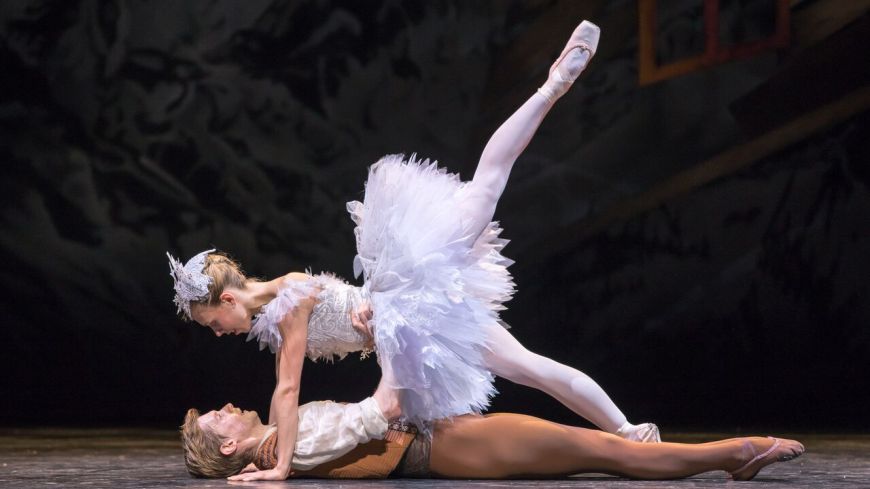
Scottish Ballet Orchestra under Jean-Claude Picard
This brilliantly conceived programme pairs two contrasting ballets featuring Stravinsky scores, in which each dramatic narrative shares a similar subtext where a femme fatale predator aims to disturb and disrupt the status quo.
Hans Christian Andersen's dark fairytale “The Ice Maiden” (1861) set in the Swiss Alps is the story of a young boy, Rudy who has been cursed with a kiss by a sinister snow queen. Adapted into a one act ballet, Le Baiser de la Fee (The Fairy's Kiss) in 1928, Stravinsky’s score was composed as an homage to Tchaikovsky, incorporating several of his early melodies and songs. In 1960, a new production choreographed by Kenneth MacMillan for the Royal Ballet was also performed at the Edinburgh Festival; this revival marks the 25th anniversary of his death.
Scene 1 transports us to a bleak mountain glen, the backdrop like a Fauvist painting depicting a mysterious mythical world. A group of long haired sprites leap across the stage, heralding the arrival of the beautiful fairy queen of the glaciers, who glistens in pure white with a dazzling tiara, pirouetting gracefully en pointe. A mother wrapped in a shawl holding her baby, is struggling to walk any further and collapses on the ground. As if a kindly gesture, the Fairy kisses the child on the forehead.
Around twenty years on, the child now grown up is enjoying the fun of the fair, dancing with a peasant girl, his fiancée at a village fete, simply staged with a minimalist design of wooden slats for roofs and windows. The party is disrupted by a Carmen- like gypsy girl, a flower behind her ear, who flaunts her stuff and flirts with the young man, cutting in on his romantic duet. The flowing, melodic score switches in emotional mood and tempo as he is caught under her bewitching spell.
The series of intimate pas de deux with Andrew Peasgood and Constance Devernay is beautifully composed blending close embrace and fast-paced lifts with high flying Catherine wheel acrobatic flips. To balance the quaint, traditional folk dance sequences, MacMillan, clearly wanted to break conventions of classical ballet to express real passion in these sensual duets. In its chilling climax, the Ice Maiden shows a dark empowerment over the young man, drawn into her ice cold world for eternity, his destiny sealed by that first fateful kiss.
“Mild protests could be heard from the beginning," commented Stravinsky about the premiere of “The Rite of Spring” in May 1913 composed for Nijinsky and Diaghilev's Ballets Russes. With dissonant harmonies and pulsating rhythm the audience was outraged by this revolutionary modernist music and the graphic story of a Russian pagan sacrifice of a virgin to welcome the birth of Spring.
A radical re-imagining of the work by Christopher Hampson, “The Rite of Spring” (2013), explores themes of spiritual, moral and political conflict between two brothers played out in two parts, Then and Now. The beautifully sculpted set is like a giant white, oval dish, split down the middle with high curved sides and wide rim. Dressed in long, flowing black Hakama “trousers”, two young men are focused on the ritual of martial arts, a display of thrusts, throws and kicks which meticulously match the syncopated rhythm and sharp beat of the music.
Their calm concentration is broken by the arrival of a woman, dressed in a white dress, who seems to take control centre stage, her arms raised as if conducting the precise timing of their movements.
The action then moves to a prison cell where the older brother is in commando gear and boots, and his brother stripped to his underpants. The scenario relates to the alleged torture of prisoners by British soldiers during the Iraq war as an unlawful policy of interrogation. Hooded, beaten and thrown around the floor, he scrambles up the walls, desperate to escape until the girl re-appears dressed in black, coaxing him to follow.
Even if you have heard the score many times, Stravinsky’s soaring, savage music can still jangle and jitter your nerve ends. Combined with the physical intensity of the two brothers in mortal combat, the cold hearted brutality choreographed with such realism, is like a punch in the stomach. In the final moments of this dance to the death, the seamless, synchronised movement and music is simply spellbinding in its emotional ferocity.
It was said of Nijinsky that he created a movement style that would embody both the logic and the frenzy of Stravinsky's music. Hampson has clearly emulated the creativity of the original choreography afresh with potent energy and breathtaking, dramatic vision.
Show times:
Festival Theatre, Edinburgh, 11 – 13 October, 2017
His Majesty’s Aberdeen, 24 – 25 October, 2017
Eden Court, Inverness, 3 to 4 November, 2017
Royal Opera House, London, 18 – 19 October, 2017
.”

